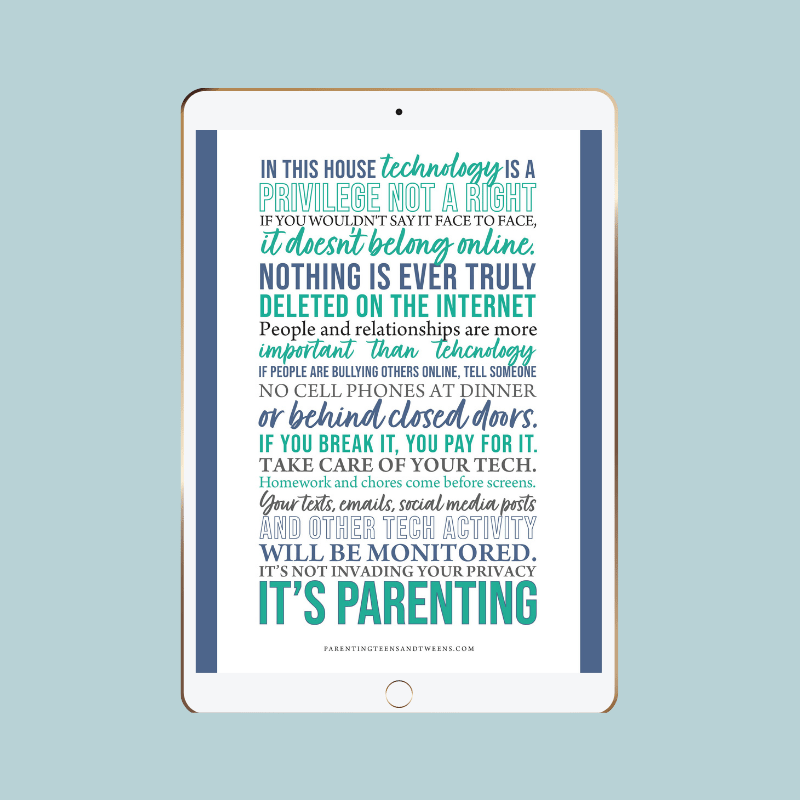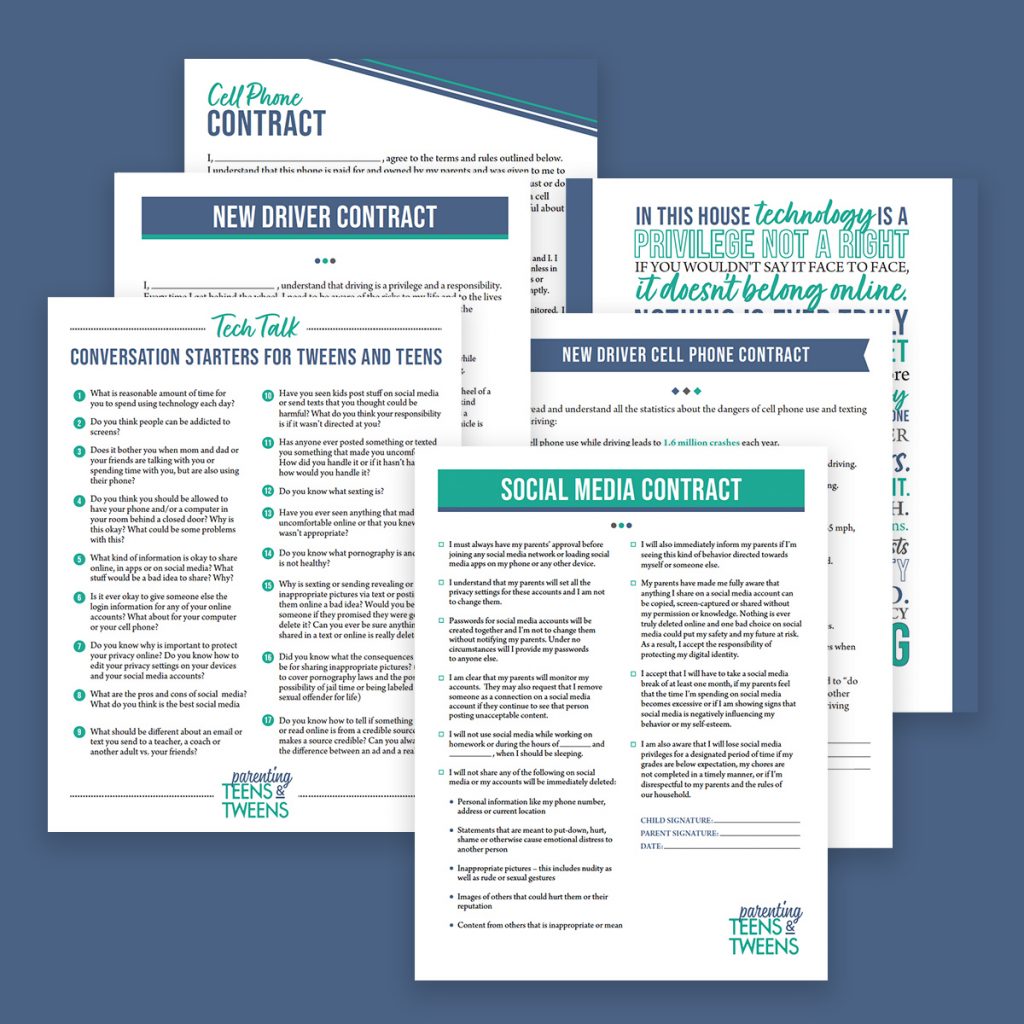
Parenting adolescents is hard.
But then you add in technology, and it feels almost impossible.
Managing tech usage makes a complicated parenting stage even more difficult
First, there is the worry that keeps us up at night.
We worry about what our teens might be seeing online, or what they might be doing, or WHO they might be meeting.
Then, there are just the daily battles of trying to get them to turn off the devices and plug into life.
While the data is clear that tech and social media are a big reason why this generation faces unprecedented levels of anxiety and depression, it’s also challenging when everything is accessible via their devices right now: homework, study apps, schedules, exercise routines, meetings, games, and entertainment.
The truth is, sometimes tech can improve our lives, but where is the balance? When is enough, and how do you know when you’ve crossed the line?
There isn’t one easy answer when parents are tearing their hair out over tech, but there are tools we can use to make it easier.
Setting (and enforcing) technology rules and boundaries is critical to parenting today
So, why are ground rules important when it comes to technology and adolescents?
When expectations are clear, at least on some basic principles, our teens understand where we stand. It also gives a starting place for conversations on some pretty tough topics we need to discuss with our teens.
Are you looking for a cell phone contract that can help you take the emotion out of handing your child a device? Check out our cell phone contract here.
The first thing parents need to address is that technology is NOT a right
Our teens and tweens oftens have a hard time understanding the difference between what is a right and what is a privilege.
They have a right to shelter, food, an education, clothing, and yes, even our love.
But even that has boundaries on it. By food, that doesn’t means we’ll fund their daily Frappuccino habit, and by clothing, we don’t mean brand-new $300 kicks every six months, and love doesn’t mean letting our kids get away with every negative action.
Related: The Best Parental Control Apps for Parents with Tweens and Teens
The same holds true for technology. Yes, our kids do need some access to a device for their education, whether it is for research, learning videos, apps, or class information. Many schools are now providing laptop computers and tablets for each student to use for their personal use.
In high school, many teachers rely on students having a mobile phone where they can access portals, learning apps or even to turn in assignments. These technologies are now fundamental parts of our society, and students need to learn how to use them responsibly and safely.
But that doesn’t translate into a right to brand new expensive mobile phones with all the bells and whistles along with unrestricted access and unlimited amounts of time to spend on all these tech toys.
Helping them navigate this new paradigm has become part of our job as parents and caretakers. It is up to us to set the same rules and boundaries for technology that we do for other aspects of their lives.
Technology is a privilege, one that they earn by demonstrating they can be responsible. This might mean they pay for use or earn screentime. They may need to show us in other areas of their lives that they have the maturity to handle some of the temptations and risks that come with technology. Or you may choose to implement boundaries that are for every member of your house, such as no phones at bedtime or at the table.
Here are the tech rules you must discuss with teens
Digital Citizenship
It’s amazing how the rules for interacting with others online can be so different than in real life.
How many of us have seen someone post something on Facebook and thought, “Wow, this person would never say something like this to my face.”
The anonymity that the internet provides emboldens some people to act before they think.
When they don’t have to actually see the face of the person who is the target of their words and process the way it hurts or demeans them, it is so much easier to say hurtful things.
Teaching our children that they shouldn’t act any differently online than they would in the real world is essential to parenting this generation.
Most importantly, we have to model this for our children. Many adults post online thinking their comments will never be seen by their family, but this simply isn’t true. Additionally, we should always post or comment thinking that someone else’s son or daughter may be reading it.
There Is No Such Thing As Delete On The Internet
Tell your children to imagine that they are 18 years old and they’ve just applied to the college of their dreams. They’ve worked hard to get good grades and test scores and crafted a great essay. It seems like the college is a great fit and offers everything they want and need to be successful.
When your teen’s application comes across the admissions officer’s desk. They decide to do a quick Google search and social media check. What pops up?
Hopefully, nothing negative, but as more teens are finding out today, their digital footprint can wreak havoc on their futures. For some, their photographic history and even the memes they post may not represent them in the most positive light.
It might be a stupid selfie they snapped at a party where they were holding a beer or an image of themselves in an inappropriate costume. They stuck it on Snapchat, and a classmate grabbed a screenshot and posted it on Instagram.
Oops.
It’s possible that they didn’t even know someone snapped a photo of them making a lewd gesture at a school pep rally and posted it on Facebook or sent it to people in a group text where it made it onto someone’s social media.
So many of these incidents are momentary youthful indiscretions that wouldn’t have mattered even a decade ago.
But that was then, and this is now.
Our tweens and teens must know that their cyber-identities are made up of every single thing they write and post online, as well as every single photo other people take of them and post online.
Hitting the delete key is often not enough to wipe these mistakes clean, and they can have serious consequences for their future. While many colleges and employers can overlook some small missteps, such as drinking or a lewd gesture, many organizations do not want volatile people on their grounds.
Everything online is up to interpretation, and it’s their job to try to manage their digital identity.
Relationships matter
Small talk and eye contact used to be something most people did naturally as part of interactions with other people. Now, not so much.
How often do we see kids hanging out and instead of talking to each other, they’re all sitting around staring down at their phones?
Does your child regularly get out of the car when you drop them off somewhere and sort of grunt a goodbye as they continue texting or watching a silly cat video?
Maybe you have a tween or teen who would rather spend hours playing a video game than spend time with his family playing a board game or hanging out.
It can become so easy to allow technology to get in the way of having real conversations and making real connections.
Our teens and tweens must learn to set limits for themselves for healthy technology use and when and where it’s time to put away their phone and pay attention to the people around them.
Related: 8 Tips to Help Your Teen Communicate More Effectively in Today’s Digital World
Speak Up
We’re hearing too many tragic stories of tweens and teens taking their own lives because they’ve been harassed by their peers, with technology being the main instrument of torment. In many of these cases, others who were uninvolved were aware of what was happening and stayed silent.
Related: Our Teen Was at Risk for Suicide, Here Are 7 Steps We Took Next
Nobody wants to be a snitch or a tattle tale, but with online bullying as prevalent as it is today, there are times when our kids need to be willing to go to a trusted adult and tell them what is going on.
When we talk to our kids about cyberbullying, it often is out of our concern that they will be a victim. What we don’t always think about is coaching them on how to handle it if they know someone else is being bullied.
They need to know that speaking up takes courage and is the right thing to do. As Dumbledore says in the Harry Potter books, “It takes a great deal of bravery to stand up to our enemies, but just as much to stand up to our friends.”
We also need to reassure our children that if they speak up, they won’t be punished or suffer retribution.
You may also like: How To Protect Your Teen’s Self Esteem From Social Media Threats
A NO ZONE For Cell Phones
There are some places where a cell phone doesn’t have any place.
One of those is most definitely at the dinner table. Considering how busy our schedules are, most families rarely get to sit down and have a meal together anymore. On the rare occasions it does happen, technology shouldn’t be allowed to interfere.
Families with uninterrupted meals together have kids who generally do better in school, are less likely to be tempted to try drugs and alcohol, and they also benefit from better mental health.
One of the main reasons for all of these positive outcomes is what happens at the dinner table. Parents get a chance to actually talk with their kids. They find out what is happening in their lives. They also get to observe their children and may be able to spot early signs of behavior changes or other indicators that things just aren’t quite right.
All of this stops happening when cell phones enter into the mix. For some families, eating together is challenging because of sports schedules, activities, jobs, school work or other valid reasons. Whenever you have the opportunity to spend time with your big kids, make it a phone-free time.
This can be tough, however, and many adolescents struggle with putting their phones down (teen cell phone addiction is a real thing). There are products like a phone lockbox that can help.
Simply put all your devices into the box for a set amount of time (Thirty minutes at dinner, 45 minutes during homework time, 90 minutes for a movie) so you can remove the temptation. It’s a great way to instill healthy habits and have great, uninterrupted quality time.
No No At Night
Another place that cell phones don’t need to be is in rooms behind closed doors. This is a good rule 24/7 for younger tweens and teens, because having tech in non-communal spaces opens up even good kids to unnecessary temptations and trouble. At the very least, though, this should be enforced at night.
More and more studies show that when technology is allowed in kids’ bedrooms, it interferes with them getting adequate sleep. Some stay up too late doing homework; others secretly text friends until all hours and check social media.
Even the blue light many of these devices emit messes with the body’s natural circadian rhythms and can keep kids from getting quality rest.
Consider having a designated overnight charging parking lot where everyone in the family puts their phones before bed. It’s not just good for tweens and teens, but moms and dads can also benefit from improved sleep.
Plus, what a great way to role model good choices.
Read more here: The Most Important Reason Teens Should Not Have Their Phones At Night
You Break It, You Pay For It
Many life lessons come with the privilege of technology, and they aren’t all about how to use it correctly. Computers, tablets, and iPhones are not cheap, and keeping track of and taking care of them properly is important.
Ensure your tweens and teens know exactly how much is invested in their devices. Establish a policy from the beginning about their responsibility regarding repairs or replacement.
Should they be lost, broken, or have a Starbucks Latte spilled on them, what is it going to cost them?
It also doesn’t hurt for them to have a little skin in the game up front. Perhaps a condition of them getting any of these devices in the first place is that they have to pay for part of it.
Or maybe they will have to contribute towards the monthly bill. At the very least, encourage them to be proactive and purchase a sturdy case. These days they can get an Otter Box for under $25.
Also, don’t forget to talk to them about data charges, roaming, app purchases, and anything else they may need to pay for.
Establish what comes before technology use
A great book for all teenagers to read is the 7 Habits of Highly Effective Teens (or the original 7 Habits of Highly Effective People is good too).
In my opinion, the most valuable habit is #3 “Put First Things First.” So many adults struggle with this and that’s why the sooner we can help our tweens and teens put it into practice, the better off they will be. Consider it an early graduation gift.
Texting friends, playing the latest gaming app, and checking social media are all activities that come after homework and chores.
Setting designated “off” times for phones, particularly with a tween who just acquired their first phone is not a bad idea. This way, they have some time set aside already. As your kids get older, more freedom may be in order, so they begin learning to manage their own schedule.
Either way, ensure proper consequences are in place if grades are suffering or the trash isn’t taken out on schedule.
Technology Use Will Be Monitored
Yes, most of us trust our tweens and teens, but they are still kids. And even good kids can make bad choices. In fact, tweens and teens are in a developmental stage that causes them to be wired to do dumb stuff because their brains aren’t fully formed yet.
So, instead of equating trust with blind faith and total freedom, why not trust them within the boundaries of their life experience and brain development?
Note: We believe that technology usage should be monitored. Bark is the best tool that we have found currently on the market.
Truth: It’s practically impossible to read every one of your kid’s text messages, snapchats, or Instagram DMs each day — and don’t even get us started on going through their web history! But we want to share a tool that’s been incredibly useful for many families.
We recommend Bark, a service that monitors your kid’s online activity for potential dangers, filters out websites you don’t want them visiting, and even helps you set healthy screen time limits to give them that all-too-important digital downtime! 🙌
It’s pretty hard to parent in the age of TikTok and Snapchat. But if you could use some help keeping your child safe online, we suggest giving Bark a try.
For more information or to sign up, please visit here.

Technology is incredibly powerful and gives access to many things our kids have never seen or dealt with before. Many of us as adults have a hard time with it all.
Monitoring is not helicopter parenting. It’s responsible parenting. Think about the way social media can make us feel sometimes.
It’s easy to fall into the comparison trap and feel bad about ourselves. Or how often do you want to just tell someone off who is posting stuff you don’t agree with, but you stop yourself at the last minute and delete it?
Now think about our teenagers in the same position. Everything is magnified in the teenage mind. And self-control…. yeah, that’s not exactly a teenager’s strong suit either.
There’s also the embarrassment factor going on here as well. Sexting, porn, naked selfies, and hook-ups, these aren’t topics our teens are dying to talk with us about. If they can avoid these discussions, they will, but that doesn’t mean they aren’t seeing this stuff.
Parenting is just as important in the digital world as in the real world. Our teens and tweens need our supervision and our guidance. We have to help them gain the skills and discernment that are required to navigate online safely and responsibly.
This is why monitoring their internet and cell phone activity is the right thing to do. Be upfront about it, and let them know you will be watching, checking, and reading. If you’re not being secretive about it, then it’s not spying. It’s parenting.
No Texting While Driving (or riding their bike)
This one is a no-brainer.
The statistics are frightening. On average, eight deaths and 1,161 injuries a day in the US are caused by distracted driving.
The glove compartment is the best place for your child’s phone when driving. There are also auto-responders on most phones that can be set to remove the temptation of answering texts while driving. Some teens have created their own system, where they buddy-check each other, and a passenger takes the driver’s phone.
Before handing over the keys to any vehicle, you should have all new teen drivers sign a no texting while driving contract.
And finally, actions speak louder than words, make sure you set an example for safe cell phone use while in the car.
Your teen will never thank you for setting tech rules
We get it. Setting technology rules for teens is not fun. It will add another layer of complexity to your relationship and can cause some animosity between you and your child.
But teaching them how to use tech responsibly and keeping them safe is worth it.
Also, don’t worry if you didn’t start off on the right foot regarding technology and your kids. No matter what they say, it’s never too late to put tech rules and boundaries in place in your home.
We’ve created a downloadable version of these tech rules in our shop. It’s cute, would be great to hang on a fridge or bulletin board, and can serve as a reminder for your kids and make it easier to review the rules when necessary.
Tween and Teen Tech Rules Printable

You may also find our Managing Teens and Technology Bundle helpful as it includes the tech rules printable as well as the cell phone contract general and for driving, social media contracts,s and important tech topics to talk about with your teen.
Teen Technology Management Bundle

Parenting Tweens and Teens is hard. Here are some popular technology posts that other parents found helpful to make it a little easier.
Talking About Porn With Teens Doesn’t Have To Be Hard
What Every Parent Of A Teen Needs To Know About Tik Tok
The Unexpected But Genius Trick That Stopped Tech Battles With Our Teen







Leave a Comment